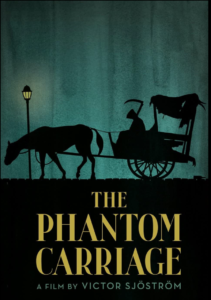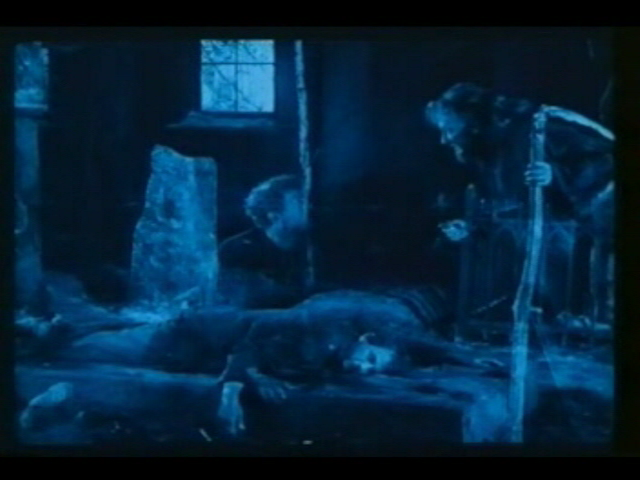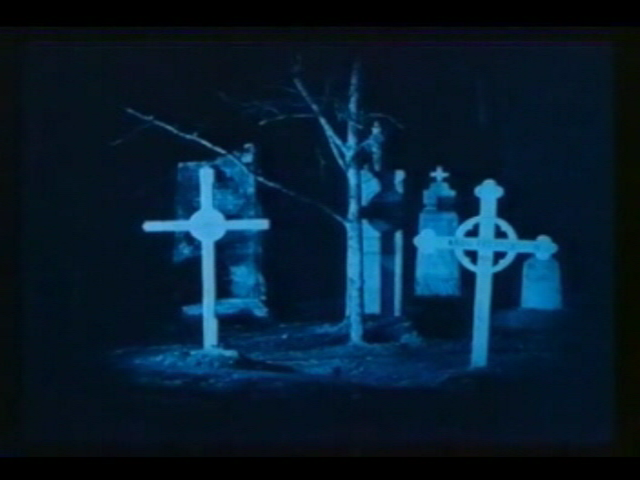|

Synopsis:
On New Year’s Eve, an alcoholic (Victor Sjostrom) is visited by the driver (Tore Svennberg) of the “phantom carriage” of death, and forced to reflect on his boorish life, during which he abused his innocent wife (Hilda Borgstrom) and rebuffed the assistance of a do-gooding missionary (Astrid Holm).
|
|
Genres, Themes, Actors, and Directors:
- Do-Gooders
- Domestic Abuse
- Flashback Films
- Ghosts
- Horror Films
- Scandinavian Films
- Silent Films
Review:
Based on a novel by Nobel Prize-winning Swedish author Selma Lagerlof, The Phantom Carriage is primarily known for the influence it had on Ingmar Bergman, who cast the film’s director (Victor Sjostrom) in the lead role of Wild Strawberries (1957), and paid explicit homage to its imagery and themes. Yet it remains an important historical milestone in its own right, due simply to its impressive technical innovations: cinematographer Julius Jaenzon, working with lab executive Eugen Hellman, created stunning “double-exposure” effects which resulted in truly memorable and haunting imagery (see stills below). Unfortunately, the narrative itself — a Christian variation of sorts on Dickens’ A Christmas Carol, and a clear precursor to Capra’s It’s a Wonderful Life (1946) — is less impressive. The film’s multiple-flashback structure is unduly confusing, and Sjostrom’s troubled protagonist is such a boorish lout — he drinks, terrorizes his wife and kids, and knowingly tries to infect as many people as possible with his tuberculosis — that it’s truly difficult to feel any sympathy for him as he cowers at death’s door. Regardless of its narrative shortcomings, however, film fanatics will surely want to check out this film — which Bergman reportedly re-watched every year after he first stumbled upon it at the age of 15 — at least once, for its stunning visuals and historical relevance.
Note: See Wikipedia’s entry on the film to read more about its production history and subsequent influence on cinema.
Redeeming Qualities and Moments:
- Julius Jaenzon’s innovative double-exposure cinematography


- Many haunting images


Must See?
Yes. Listed as a film with Historical Importance and a Personal Recommendation in the back of Peary’s book.
Categories
(Listed in 1001 Movies You Must See Before You Die)
Links:
|





One thought on “Phantom Carriage, The (1921)”
WOW! Certainly a must-see!
Hadn’t seen this one til now – which is a little surprising since I think I did know it had influenced Bergman and, at least in my teen years, I have been a major Bergman film fanatic. (In particular, I think I’ve seen ‘Wild Strawberries’ more times over the years than I could begin to count.)
If there is a pile of film discs on your desk (as there tends to be on mine at all times), a 1921 silent may not have an easy time edging its way to the top. But last night I had an “Oh, go for it!” feeling come over me. And I’m glad I did.
I found myself mesmerized early on and captivated throughout. Yes, the Sjostrom character is rather awful in many ways but it seems to me he has to be for the film’s purpose. I didn’t find the film’s structure particularly confusing.
What I was struck most by is Sjostrom’s direction – there’s a confident naturalism at work that seems to set the film apart from others of this period. (American silents, at any rate.) The fine, natural performances of the cast make for easier viewing today of a film inching its way to becoming 100 years old.
The film’s ghost story aspect is chillingly conveyed. As the assessment states, the effects are stunning.
I did find myself confused by one point: according to the carriage legend, the new driver who takes over on New Year’s Eve is apparently supposed to be someone who led a corrupt life of some sort prior to death on that night – yet, at other times, we’re told the new driver will be either the last person who had something fatal happen to him/her or the last person simply to die before the stroke of midnight.
But the rest of the film seems rather straightforward. There is a resemblance to ‘A Christmas Carol’, but I kept thinking of the plays of Eugene O’Neill, esp. the ones with scenes inside a bar. (O’Neill’s plays started appearing around this time.)
I noticed when I recently watched ‘The Big Parade’ that a major contribution to the success of a revival of a silent rests with the addition of a new film score that matches it seamlessly. That was the case with ‘TBP’ and it’s certainly the case here. I didn’t catch the name of the composer of either score but, in each film, the score acts like another character in the story, sensitive to every nuance and turn – almost as if it has lines to speak.
Highly recommended viewing!